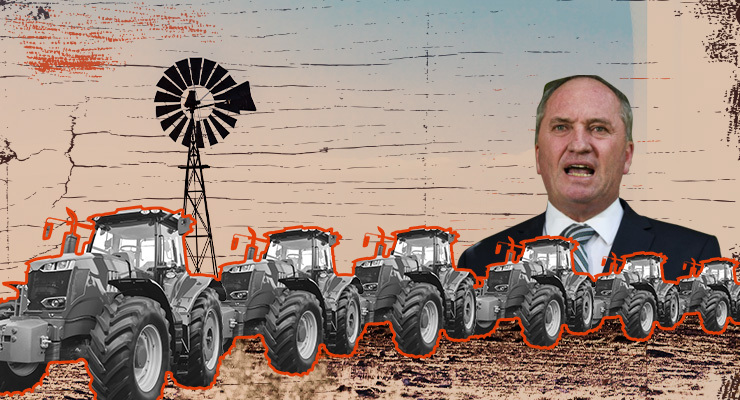
The National Party in NSW has suffered a steep decline in its membership and now has fewer members than the Greens Party.
Figures on political party membership supplied by the Grattan Institute show that in 2015 the NSW arm of the Nationals had 4466 members. By 2020 the number was 3036 — a fall of over one third.
At the same time, membership of the NSW ALP fell from 18,321 to 15,427, while NSW Liberal Party membership increased from 10,380 to 11,906.
The drop in National Party membership relative to its own numbers, and relative to other political parties, coincides with growing anger about the party’s pro-mining policies which put it at odds with the National Farmers’ Federation, grassroots farming organisations and other state branches of the party, as we’ve reported in recent articles.
ABC election analyst Antony Green explains the drop in numbers as likely due to the party being under attack for several years from the Shooters, Fishers and Farmers Party.
“In NSW there have been big swings against them in the whole western part of the state, much of it to do with irrigation,” Green said.
“The Nationals also tend to suffer from being the junior partner in a coalition government dominated by the metropolitan based Liberal Party. The current government has many high profile and expensive major works projects in Sydney and there was resentment at the last election that more money wasn’t directed to projects and services in regional areas.”
Is the party’s membership simply dying out? “All parties have the ageing problem,” Green said. “And people just aren’t joining organisations — political or otherwise — so much any more.”
The fall in the Nationals’ membership, though, is much faster than in other parties.
The make-up of the membership — and whether or not it reflects the community — is critical because, like other political parties, Nats branch members vote on pre-selections. As we reported this week, in May this year around 120 members of party’s New England branch preselected Barnaby Joyce over his challenger Andrew Rubin. Rubin ran on a platform of transparency in government and acknowledging climate change, but was crushed — reportedly by 100 votes.
Like other parties, the National Party does not publicly discuss its membership numbers.
Grattan’s numbers, provided to Crikey, are derived from NSW Electoral Commission data. NSW is the only electoral agency in Australia which requires political parties to provide membership numbers — not that they are easy to find.
“The data scrape is far from straightforward,” Grattan’s former executive director John Daley told Crikey. “You have to know where to look and it’s a matter of collating from different areas of the website.” Grattan added its 2020 data to numbers for 2015-2018 calculated by the political blog Boilermaker Bill.
In dollar terms, the NSW Liberal and NSW National parties outranked their political opponents because of higher membership fees, as 2019-20 data shows.
| Party | Membership | Fees |
| ALP | 12,803 | $ 472,615 |
| Liberals | 11,906 | $ 1,001,061 |
| Nationals | 3063 | $ 320,950 |
| Greens | 3638 | $ 235,300 |
| Country ALP | 2624 | $ 98,090 |
Grattan extrapolated NSW data to produce implied national membership figures. These were:
- ALP — 48,505
- Liberal — 37,434
- Nationals — 9,631
- Greens — 11,500
The total (implied) membership of political parties in Australia was around 96,000 people or 0.37% of the population.
Daley’s analysis is that this low number is linked to there being “less policy to rally around”, and party members having “less influence over party policy positions”.
And the result? “Falling membership makes it easier to influence if not stack branches to pre-select people on the basis of their factional fealty rather than their appeal to mass branch members, reinforcing the drift towards patronage, the power of shibboleths, and reluctance to undertake ‘courageous’ policy reform,” he wrote in a Grattan Institute report.








I do think some people are becoming aware that the Nats stand for water theft and coal mining.
True, and promotion of barnabananas and the ongoing, extreme pro global warming commentary by canamanbecaravan probably haven’t helped.
Daley’s summary is spot on. Joyce and fellow travellers don’t give a rat’s about the numbers in the local branch. It just needs to deliver them pre-selection for the next round of screwing taxpayers, opening coal mines and drinkies with Gina.
And Rooter of All thought he was entitled to keep the Rhinehart $40,000 cheque for ‘services’ rendered.
A look at Joyce and the damage he’s doing was long overdue. Truth is, he’s a very, very average MP who, I firmly believe, is motivated only by greed and revenge. Read the pieces – well done!
And ‘playing the system’.
An alcoholic
Last federal election figures
Greens 10.40% Seats 1
National 4.51% Seats 10
When I joined the ALP in 1956 as a keen and trusting 17 year old in 1956 if one arrived late for a meeting, which were held in the old Ipswich Trades Hall, those persons would be obliged to stand s all available seats would be taken.Now, by all accounts, they are lucky to have a quorum.I didn’t renew my membership after the ALP government of the time, (Hawke/Keating), sold the Commonwealth Bank and Qantas.Of course I still vote ALP because we can’t have the other bastards on even for a nanoecond.